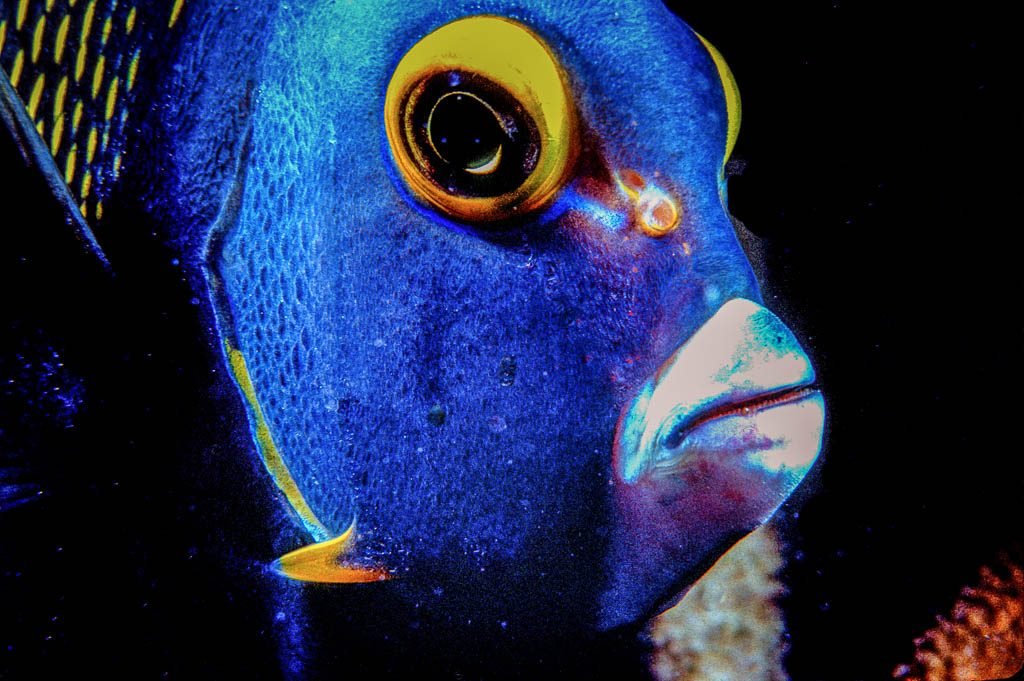
Fish Photography: The Ultimate Undersea Skill

In keeping with our promise to provide Shoot Like a Pro photography tips, this time we’ll delve deeper into fish photography. Photographing fish is widely considered to be the most rewarding specialty in underwater photography. In his book, Mastering Underwater Photography, renowned fish photographer, Carl Roessler, dubbed it “the ultimate undersea skill.” While an entire book could be written on this subject, what follows are some quick tips for novice underwater photographers to help them successfully photograph these moving targets.
Use the right tools
These days just about any digital camera is a capable tool for making fish pictures. When it comes to selecting an underwater strobe, any brand will do. Just make sure the angle of light coverage is sufficient for whichever lens setup you use. For DSLR camera systems the workhorse lenses are 105mm and 60mm macro lenses. For sharks, dolphins or whales, you’ll need a 24mm, 20mm or 16mm full frame fish-eye lens. Zoom lenses with these ranges work fine.
Composition and negative space
Composition is the harmonious arrangement of forms, space and colors within the frame of your image. Think about the elements you’re photographing and either shoot from different angles, or wait for the fish to move into a better position on their own. Should the fish be framed vertically or horizontally? The dominant subject does not have to be centered exactly in the middle of the frame, but it must be in balance with other objects. Fish subjects continually move in and out of attractive poses. When you see the scene shaping up, be prepared to trigger the camera’s shutter. Negative space, simply defined, is the picture area that is not the main subject. It is the main ingredient that can make or break a photograph. Ideally, your main subject should fill two-thirds of your picture area. The remaining background should be clean, colorful and non-distracting. Try to achieve some level of color separation between subject and background.
Study fish behavior
Learn all you can about the behavioral patterns such as swimming, spawning, feeding and defensive habits. In time, you will be able to better predict how your subject will react in different circumstances. You’ll also need to collect a few good books on ichthyology if you ever hope to accurately identify the vast number of fish species there are in the world.

Male & female Sockeye salmon, Oncorhynchus nerka, Adams River, Tsútswecw Provincial Park, British Columbia, Canada
Stalk, don’t chase
It’s futile to chase any fish, as they are constantly alert to predatory behavior. When frightened, either by sight, sound or vibration, they’ll flee, which in turns sends a danger signal to other fish nearby. An underwater photographer must penetrate this piscatorial warning system without detection. Inspect your quarry first from a distance and decide your best approach strategy. Research spearfishing techniques to learn how to move and dive silently. Don’t look directly at your subject directly and don’t make any sudden movements. Pretend to be interested in something else.
Approach tactics
Use whatever cover the reef terrain provides and keep the sun behind you. As you slowly creep forward, use as little extra movement as possible and decide how you will frame your subject. If the fish appears nervous, stop and play the waiting game. Every fish has a minimum approach distance. If you violate this limit, the fish will likely swim away. If the fish seem really skittish, simply leave the area and return later in the dive to try again. By then, they will have forgotten about you and resumed their normal routine.
Where do fish go to school?
Large shoals of fish are usually active around reefs or kelp beds that that face the open ocean, coral overhangs, shipwrecks, piers, rock jetties and points of land that jut out into the water. When a current is running, fish tend to gather at the head of the current. Pelagic fish are constantly on the move and seek refuge in open water.
The eyes have it
The fishes’ eyes, and facial features forward of the eyes, should be in sharp focus. If the eyes are soft, you might as well delete the image and do it over.
Can fish tell time?
Certain times of day are ideal for fish photography than others. Generally, you’ll see more fish during a flood tide then at ebb tide, and more fish congregate near shore at high tide than low tide. Some species of fish avoid sunlight altogether and inhabit deep water during daylight hours. Diving at night allows the photographer to get very close to some species that are normally unapproachable during the day. It’s dead easy to bring your lens to within a few inches of fish that are asleep.
To bait, or not to bait?
Baiting, or chumming, was once thought to be a perfectly acceptable method to lure fish into position. However, people now realize baiting promotes unnatural behavior in fish, and may actually cause harm if the bait is not a natural food source. If the situation absolutely calls for baiting, such as is needed to attract sharks, be sure the food being offered closely simulates the fishes’ natural diet.

Underwater photographer Ken Kiefer gets ready to photograph a large tiger shark, Tiger Beach, Bahamas
Reflectivity
Fish differ in in color, and their capacity to reflect light varies. A smaller f-stop than normal should be used to prevent overexposure with fish that have highly reflective scales (i.e. jacks, barracuda, tarpon, etc.); use a larger f-stop to avoid underexposure with fish that have extremely absorptive scales (i.e., China rockfish, dogfish, squirrelfish, etc.). You may also compensate for reflectance by adjusting your camera’s ISO setting, moving your strobe closer to your subject, or further away, as the case may be.
Countershading
In order to sneak up on their prey, sharks use countershading as a form of camouflage Their darker top allows for them to go unnoticed by prey that swim closer to the surface, as their color blends into the dark shadows of the deep ocean. The shark’s’ underbelly is lighter in color. When prey are looking skyward, the shark’s body blends into the lighter surface colors of the ocean.
As with most things in life, practice makes perfect. Spend as much time as possible in the water improving your diving skills. Learn from your picture mistakes by asking yourself what went wrong and what went right. Experiment with multi-strobe lighting and try altering the mood, using spot, side or back lighting techniques. Challenge yourself to create something unique with your imagery, and your ultimate reward will be fish portraits that show you have mastered the ultimate undersea skill.
Until our next dispatch, dare to Explore… Dream… Discover.
Join Us in Svalbard, Norway
“Interested in stories about underwater photography and protection of our oceans’? What are you doing 14-24 August this year? I am so pleased to say that our friends across the sea, both fellows of the explorer’s club and much much more, are joining us on board the M/S Quest these dates! Come join Jett Britnell, Kathryn Britnell and PolarQuest to the realm of the Polar Bear, the haven for Walrus and the beautiful landscape of Svalbard!”
~ Marie Lannborn Barker, CEO, PolarQuest













































